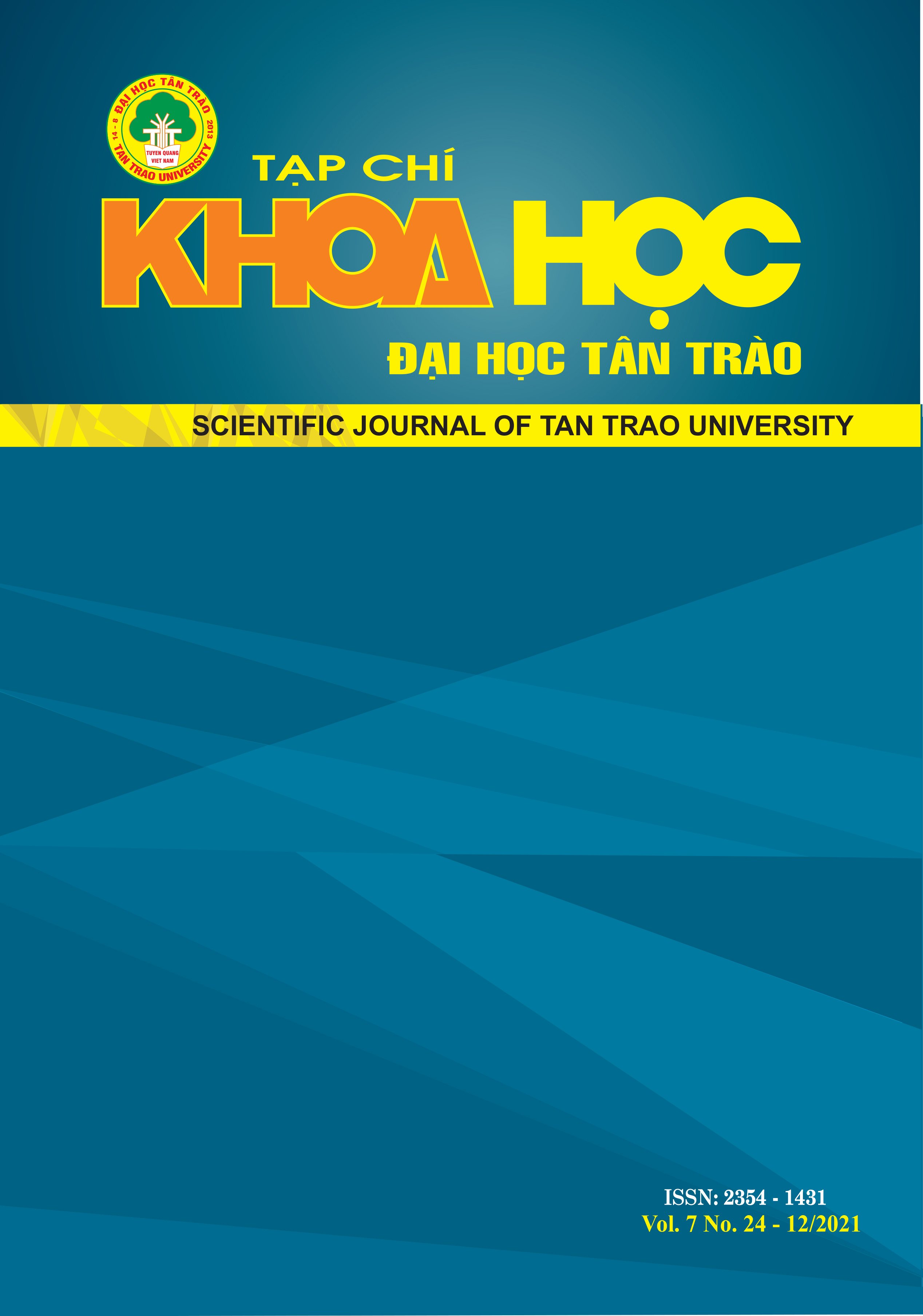XÂY DỰNG LẠI MÔI TRƯỜNG 3D TỪ DỮ LIỆU THU ĐƯỢC CỦA CẢM BIẾN RGB-D
DOI:
https://doi.org/10.51453/2354-1431/2021/692Từ khóa:
Dá»±ng lại môi trÆ°á»ng 3D RGB-D camera Äám mây Ä‘iểmTóm tắt
Tái tạo môi trường 3D là một hướng nghiên cứu rất quan trọng trong lĩnh vực công nghệ Robot và thị giác máy tính. Hướng nghiên cứu này giúp Robot xác định vị trí và tìm đường đi trong môi trường thực tế hoặc giúp xây dựng hệ thống hỗ trợ dành cho người mù và người khiếm thị. Trong bài báo này, chúng tôi giới thiệu một cách tiếp cận đơn giản và được thực hiện trong thời gian thực để tái tạo môi trường 3D từ dữ liệu thu được từ cảm biến rẻ tiền. Quá trình thực hiện là được trình bày chi tiết từng bước và được minh họa bằng mã nguồn. Đồng thời, các loại cảm biến thu thập dữ liệu hình ảnh từ môi trường hỗ trợ tái tạo môi trường 3D theo cách tiếp cận này cũng được trình bày và giới thiệu. Dữ liệu được tạo ra là dữ liệu đám mây điểm không
có cấu trúc cũng được trình bày và minh họa trong các số liệu có sẵn. Đồng thời các hình ảnh về môi trường cũng được thể hiện trực quan
Tải xuống
Tài liệu tham khảo
[1] W. B. Gross, “Combined effects of deoxycorticosterone and furaltadone on Escherichia coli infection in chickens,” American Journal of Veterinary Research, 45(5), 963–966, 1984.
[2] H. Durrant-Whyte, T. Bailey, “Simultaneous localization and mapping: Part I,” IEEE Robotics and Automation Magazine, 13(2), 99–108, 2006, doi:10.1109/MRA.2006.1638022.
[3] P. Skrzypczynski, “Simultaneous localization and ´ mapping: A feature-based probabilistic approach,” International Journal of Applied Mathematics and Computer Science, 19(4), 575–588, 2009, doi:10.2478/ v10006-009-0045-z.
[4] “Depth Sensing Technologies,” https://www.framos.com/en/ products-solutions/3d-depth-sensing/depth-sensing-technologies, 021, [Accessed 20 Nov 2021].
[5] “Depth Sensing Overview,” https://www. stereolabs.com/docs/depth-sensing/, 2021, [Accessed 20 Nov 2021].
[6] R. Li, Z. Liu, J. Tan, “A survey on 3D hand pose estimation: Cameras, methods, and datasets,” Pattern Recognition, 93, 251–272, 2019, doi:10.1016/j. patcog.2019.04.026.
[7] J. Kramer, N. Burrus, F. Echtler, H. C. Daniel, M. Parker, Hacking the Kinect, 2012, doi:10.1007/ 978-1-4302-3868-3.
[8] R. Chatila, J. P. Laumond, “Position referencing and consistent world modeling for mobile robots,” in Proceedings - IEEE International Conference onV.H Le et al./No.24_Dec 2021|p. Robotics and Automation, 138–145, 1985, doi:10. 1109/ROBOT.1985.1087373.
[9] T. Bailey, H. Durrant-Whyte, “Simultaneous localization and mapping (SLAM): Part II,” IEEE Robotics and Automation Magazine, 13(3), 108–117, 2006, doi:10.1109/MRA.2006.1678144.
[10] J. Aulinas, Y. Petillot, J. Salvi, X. Lladó, “The SLAM problem: A survey,” in Frontiers in Artificial Intelligence and Applications, volume 184, 363–371, 2008, doi:10.3233/978-1-58603-925-7-363.
[11] L. Ling, PHD Thesis - Dense Real-time 3D Reconstruction from Multiple Images, Ph.D. thesis, 2013.
[12] A. J. Davison, I. D. Reid, N. D. Molton, O. Stasse, “MonoSLAM: Real-Time Single Camera SLAM,” IEEE Transactions on pattern analysis and machine intelligence, 29(6), 2007.
[13] K. Mitra, R. Chellappa, “A scalable projective bundle adjustment algorithm using the L norm,” in Proceedings - 6th Indian Conference on Computer Vision, Graphics and Image Processing, ICVGIP 2008, 79–86, 2008, doi:10.1109/ICVGIP.2008.51.
[14] Z. Zhang, Y. Shan, “Incremental Motion Estimation Through Local Bundle Adjustment,” Technical Report MSR-TR-2001-54, 2001.
[15] L. A. Clemente, A. J. Davison, I. D. Reid, J. Neira, J. D. Tardós, “Mapping large loops with a single handheld camera,” in Robotics: Science and Systems, volume 3, 297–304, 2008, doi:10.15607/rss.2007.iii.038.
[16] H. Strasdat, J. M. Montiel, A. J. Davison, “Scale driftaware large scale monocular SLAM,” in Robotics: Science and Systems, volume 6, 73–80, 2011, doi: 10.7551/mitpress/9123.003.0014. [17] B. Nicolas, “Calibrating the depth and color camera,” http://nicolas.burrus.name/index. php/Research/KinectCalibration, 2018, [Online; accessed 10-January-2018].
[18] C. Jason, “Kinect V1 Rgb and Depth Camera Calibration,” https://jasonchu1313.github.io/2017/ 10/01/kinect-calibration/, 2017, [Online; accessed 10-Nov-2021].
[19] C. Thomson, “What are point clouds? 5 easy facts that explain point clouds,” https://info.vercator. com/blog/what-are-point-clouds-5-easy- facts-that-explain-point-clouds, 2019, [Online; accessed 10-Nov-2021]
Tải xuống
Đã Xuất bản
Cách trích dẫn
Số
Chuyên mục
Giấy phép

Tác phẩm này được cấp phép theo Giấy phép Quốc tế Creative Commons Attribution-ShareAlike 4.0 .
Bài báo được xuất bản ở Tạp chí Khoa học Đại học Tân Trào được cấp phép theo giấy phép Ghi công - Chia sẻ tương tự 4.0 Quốc tế (CC BY-SA). Theo đó, các tác giả khác có thể sao chép, chuyển đổi hay phân phối lại các bài báo này với mục đích hợp pháp trên mọi phương tiện, với điều kiện họ trích dẫn tác giả, Tạp chí Khoa học Đại học Tân Trào và đường link đến bản quyền; nêu rõ các thay đổi đã thực hiện và các nghiên cứu đăng lại được tiến hành theo cùng một bản quyền.
Bản quyền bài báo thuộc về các tác giả, không hạn chế số lượng. Tạp chí Khoa học Tân Trào được cấp giấy phép không độc quyền để xuất bản bài báo với tư cách nhà xuất bản nguồn, kèm theo quyền thương mại để in các bài báo cung cấp cho các thư viện và cá nhân.
Mặc dù các điều khoản của giấy phép CC BY-SA không dành cho các tác giả (với tư cách là người giữ bản quyền của bài báo, họ không bị hạn chế về quyền hạn), khi gửi bài tới Tạp chí Khoa học Đại học Tân Trào, tác giả cần đáp ứng quyền của độc giả, và cần cấp quyền cho bên thứ 3 sử dụng bài báo của họ trong phạm vi của giấy phép.


